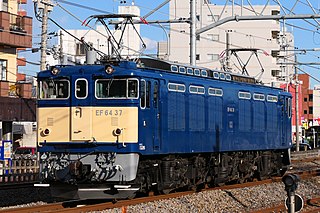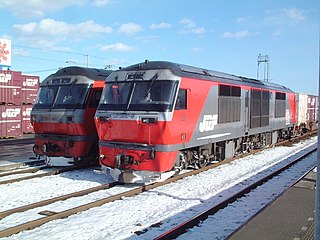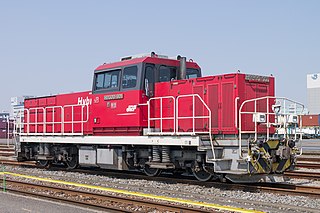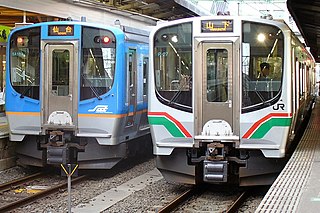
The Class EF60 (EF60形) was the first Japanese second-generation DC electric locomotive type with six driven axles, and the first versions used the same MT49 390 kW traction motors as the ED60 and ED61 designs. A total of 143 locomotives were built between 1960 and 1964 by Kawasaki, Tōshiba, Tōyō & Kisha Seizō, and Mitsubishi. The class was split between 129 freight locomotives designed to supersede the mammoth EH10s on Tōkaidō and Sanyō Main Line freight, and 14 passenger locomotives (EF60-500) to replace EF58s on sleeping car trains on the Tōkaidō and Sanyō Mainlines.

The Class DD51 (DD51形) is a B-2-B wheel arrangement diesel-hydraulic locomotive type operated in Japan since 1962. 649 locomotives were built between 1962 and 1978 by Kawasaki Sharyo, Hitachi, and Mitsubishi. The class was designed for mainline passenger and freight use with more power than the D51 and a higher maximum speed than the C62 steam locomotive classes. This was achieved by installing two 1,100 hp engines in an 18 metre long centre-cab design, unusual for mainline operation. The V12 DML61 engines were developed from the 6-cylinder inline DMF31 engines used in the Class DD13 locomotives. As of 1 April 2016, 29 locomotives remained in operation.

The Seibu 6000 series (西武6000系) is a Japanese electric multiple unit (EMU) train type operated by the private railway operator Seibu Railway on commuter services in the Tokyo area since 1992.

The Class EH500 (EH500形) is a Bo′Bo′+Bo′Bo′ wheel arrangement multi-system AC/DC two-unit electric locomotive type operated by JR Freight in Japan since 1997.

The Class EF64 (EF64形) is a 6-axle DC electric locomotive type operated on passenger and freight services in Japan since 1964.

The Class EF510 (EF510形) is a Bo-Bo-Bo wheel arrangement multi-voltage AC/DC electric locomotive type operated by JR Freight and East Japan Railway Company in Japan since 2002. As of 1 April 2016, the fleet consists of 38 locomotives, all based at Toyama Depot.

The Class EF66 (EF66形) is a six-axle, three-bogied (Bo′Bo′Bo′) DC electric locomotive designed for fast freight used by Japanese National Railways (JNR) and later operated by its descendants JR West and JR Freight. As of 1 April 2016, 39 locomotives remained in service, all operated by JR Freight.

The 489 series was a limited express electric multiple unit (EMU) train type introduced in March 1972 by Japanese National Railways (JNR) in Japan, and later operated by East Japan Railway Company and West Japan Railway Company (JR-West) until 2012.

The Class EF210 (EF210形) is a Bo-Bo-Bo wheel arrangement DC electric locomotive type operated by Japan Freight Railway Company on freight services in Japan.

The Class EF65 (EF65形) is a 6-axle DC electric locomotive type operated on passenger and freight services in Japan since 1965. A total of 308 locomotives were built between 1965 and 1979, with 52 still in service as of 1 April 2016.

The Class EF200 (EF200形) was a Bo-Bo-Bo wheel arrangement DC electric locomotive operated by JR Freight on freight services in Japan from 1992 until its retirement on 28 March 2019.

The Class DF200 (DF200形) is a Bo-Bo-Bo wheel arrangement diesel-electric locomotive type operated by the Japan Freight Railway Company and the Kyushu Railway Company.

The Class EF81 is a six-axle Bo-Bo-Bo wheel arrangement multi-voltage AC/DC electric locomotive type operated on passenger and freight services in Japan since 1968. As of 1 April 2016, 44 locomotives remained in service, operated by JR Freight, JR East, and JR West.

The Class HD300 (HD300形) is a hybrid diesel/battery Bo-Bo wheel arrangement shunting locomotive type operated by Japan Freight Railway Company in Japan. Following the delivery and evaluation of a prototype locomotive in March 2010, the first full-production locomotive entered service in February 2012.

The E721 series (E721系) is an AC electric multiple unit (EMU) train type operated by East Japan Railway Company on services in the Sendai area of Japan since February 2007.

The Meitetsu DeKi 400 was a Bo-Bo wheel arrangement electric locomotive type operated by private railway operator Nagoya Railroad (Meitetsu) in Japan.

The Class EH800 (EH800形) is a Bo′Bo′+Bo′Bo′ wheel arrangement multi-voltage AC two-unit electric locomotive type operated by Japan Freight Railway Company in Japan hauling freight trains on the Kaikyō Line through the Seikan Tunnel separating mainland Honshu with the northern island of Hokkaido. A prototype locomotive was delivered in January 2013 for evaluation and testing, with full-production locomotives delivered from June 2014, entering service from July 2014.

The 121 series (121系) is an electric multiple unit (EMU) train type introduced in March 1987 by Japanese National Railways (JNR), and currently operated by Shikoku Railway Company on local services in Shikoku, Japan.

The Class ED79 (ED79形) was a Bo-Bo wheel arrangement AC electric locomotive type operated on passenger and freight services in the north of Japan from 1986, originally by Japanese National Railways (JNR), and later by Hokkaido Railway Company and Japan Freight Railway Company until 2016.

The Class DD200 (DD200形) is a Bo-Bo wheel arrangement diesel-electric locomotive type on order by Japan Freight Railway for use on freight and shunting duties in Japan. A prototype locomotive was delivered in late June 2017 for testing and evaluation in the Tokyo area.

























